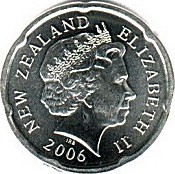| Revision as of 05:23, 27 June 2014 edit68.184.165.51 (talk)No edit summary← Previous edit | Revision as of 06:38, 29 June 2014 edit undoBobby131313 (talk | contribs)Extended confirmed users, File movers, Pending changes reviewers, Rollbackers1,819 edits Undid revision 614596444 by 68.184.165.51 (talk) Users only contributions are external links to the same site.Next edit → | ||
| Line 89: | Line 89: | ||
| ] | ] | ||
| ] | ] | ||
| ==External links== | |||
Revision as of 06:38, 29 June 2014
| New Zealand | |
| Value | 0.20 New Zealand dollars |
|---|---|
| Mass | 4.00 g |
| Diameter | 21.75 mm |
| Thickness | 1.56 mm |
| Edge | "Spanish flower" |
| Composition | Nickel-plated steel |
| Years of minting | 2006 - present |
| Catalog number | - |
| Obverse | |
 | |
| Design | Queen Elizabeth II |
| Designer | Ian Rank-Broadley |
| Design date | 1999 |
| Reverse | |
 | |
| Design | Māori carving of Pukaki, a chief of the Ngāti Whakaue iwi |
| Designer | Robert Maurice Conly |
| Design date | 1990 |
The New Zealand twenty-cent coin is the second lowest denomination coin of the New Zealand dollar. The 20 cent coin was introduced when the New Zealand dollar was introduced on 10 July 1967, replacing the New Zealand florin coin. Its original reverse of a kiwi bird was changed in 1990 when the image was moved onto the one dollar coin. In 2006 its size was reduced and its edge altered to a Spanish flower as part of a revision of New Zealand's coins, which also saw its alloy become nickel-plated steel.
Design
1967 to 1990
On 10 July 1967, New Zealand's former pre-decimal pound currency, pegged to the British pound, was changed to a decimal dollar at a rate of two dollars to a pound. Therefore, 20 cents was worth a tenth of a pound. The 20 cent coin replaced the florin coin which had been worth two shillings, or a tenth of a pound.
Like the florin, the new 20 cent coin was made of cupronickel, 28.58 mm in diameter, 11.31 grams in weight, and had 100% edge milling. The 20 cent coin retained the presence of a kiwi bird on the reverse of the florin, albeit in a different design.
The original obverses of 20 cent coins depicted Arnold Machin's portrait of Queen Elizabeth II. In 1986 the portrait was changed to the one by Raphael Maklouf, which had been introduced to the coins of the pound sterling in the previous year. Mintings of this coin from 1990 are rare.
1990 to 2006
In 1990, the new $1 and $2 coins were released to replace the $1 and $2 notes. As the $1 depicted a kiwi also, the 20 cent's reverse had to be redesigned. The new reverse side featured the well-known Māori carving depicting Pukaki, a chief of the Ngāti Whakaue iwi (tribe) of Te Arawa. In 1999, the portrait of the Queen was changed to a version by Ian Rank-Broadley which had been introduced to the coins of the pound sterling in the previous year. No 20 cent coins were minted between 1991 and 2001.
The existing 20 cent coins remained in circulation and greatly outnumbered the new design until 2006.
2006 onwards
On 31 July 2006, the new 20 cent coin was released alongside the new 10 cent and 50 cent coins as part of the Reserve Bank's "Change for the better" silver coin replacement. The new 20 cent coin had the same reverse as the 1990 to 2006 minted coins and the same obverse as the 1999-onward coins, but the coins were reduced in size. The new 20 cent coins are made of steel, covered in a layer of nickel, copper, then nickel again. The new coins are 21.75 mm in diameter and 4 grams in weight. They have Spanish flower milling around the edge, splitting it into seven sections. For their introduction in 2006, 116 million were minted, with a total value of NZ$23.2 million. The only other year of issue was 2008, where 80 million coins and a total value of NZ$16 million were issued.
The old 20 cent coins were demonetized on 1 November 2006.
Minting figures
According to Reserve Bank of New Zealand. Values are in New Zealand dollars. No large 20 cent coins were minted in 1968, 1970, 1991–2001, 2003. Due to the large amount made for the introduction of the small 20 cent, none were minted in 2007 or from 2009 onwards.
- 1967: $2,600,000
- 1969: $500,000
- 1971: $320,000
- 1972: $303,000
- 1973: $610,000
- 1974: $907,000
- 1975: $1,000,000
- 1976: $1,500,000
- 1977: $1,500,000
- 1978: $500,000
- 1979: $1,600,000
- 1980: $1,800,000
- 1981: $1,500,000
- 1982: $3,500,000
- 1983: $500,000
- 1984: $300,000
- 1985: $1,200,000
- 1986: $2,500,000
- 1987: $2,800,000
- 1988: $2,500,000
- 1989: $1,000,000
- 1990: $1,000,000
- 2002: $1,400,000
- 2004: $1,700,000
- 2005: $800,000
- 2006: $23,320,000
- 2008: $16,000,000
See also
References
- Reserve Bank of New Zealand
- http://worldcoingallery.com/countries/display.php?image=img17/131-118&desc=New Zealand km118 20 Cents (1999-2005)&query=New Zealand
- ^ http://www.rbnz.govt.nz/statistics/tables/f4/
| New Zealand currency | |||||
|---|---|---|---|---|---|
| Currency |
| ||||
| Coins | |||||
| Banknotes | |||||
| Obsolete denominations |
| ||||
| Related topics | |||||
| Economy of New Zealand | |
|---|---|
| History | |
| Currency | |
| Government | |
| Industry | |
| Economic conditions | |
| Agreements | |
| Unions and lobbyists | |